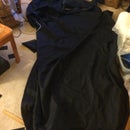Introduction: Painting Plastic Nose Cowls for Radio Control Airplanes. I Made It at TechShop
This instructable explains how to paint a vacuum formed plastic nose cowl for a radio control airplane. It is very common for plane kits to include plastic vacuum formed parts. They are always clear or white or some other color that doesn't match the color you plan on covering your airplane. I used the paint spray booth at TechShop, Allen Park, MI to do the painting.
I made it at Techshop
http://www.techshop.ws
Step 1: Prepare the Parts
For this example, I had 2 cowls to paint. One is intended to be red and one is intended to be blue. You need to cut out the parts from any extra they might have. A #11 exacto knife and scissors works well for this task. For anything you are using the exacto knife for, it works best to score the parts a bit and then fold them until they break. Trying to cut entirely through can be difficult. If your nose cowl was multiple pieces, you can use plastic cement or MEK as it's otherwise known. It's a solvent that more or less dissolves the 2 parts together. Most of these are made of styrene so you can buy strip or sheet styrene at a hobby store to reinforce the cowl a little bit if you crack it or otherwise damage it.
Once your parts are together, you can clean them up using a scotchbrite pad. This will rough up the surface a little bit and the paint will stick better. It will also remove any wax or other reside on the parts.
To hold the parts while painting, I like to glue them to some balsa sticks. For these I used a 3/16" square stick. I used a little CA adhesive and kicker to glue the balsa stick to the insides of the cowls. CA doesn't stick well to styrene so the sticks will break off very easily when your done painting.
Right before painting, wipe the parts off with a paper towl and acetone.
Step 2: The 1st Coat.
I am using some Tamiya paint that is formulated for plastic and supposedly doesn't need any primer. I went straight to color coats. If you use Krylon or Rustoleum or another generic paint from Lowes or Walmart, you will want to do the first few coats with primer and then move on to the color coat. The process is the same, except that you do it twice. Once for primer and once for color.
The first coat should be very light. Just do a dusting more or less. This lets the paint adhere to the surface and gives a base for the rest of the paint coats. Drying time between coats should be 5 to 10 minutes.
Step 3: 2nd Coat
The 2nd coat should go on a bit heavier then the dusting coat. You want to go for solidly covering the parts. You don't want to go so heavy that you get any runs. Just go until you cover it and don't see anymore of the underlying color and go no further.
Step 4: Coat 3 and 4.
The 3rd coat and 4th oat if you want one, should go on so that the part looks wet. This will dry to a nice glossy finish. You want to just achieve wet looking with the paint but not so wet that it runs. If you get a run, you'll need to use some 400 grit or so wet dry paper and sand the run off after it dries and apply a few more coats. If you get a run, it will need much more then the 5 to 10 minutes drying time to harden. Just be careful and don't go crazy with the paint and you won't get one.
After the last coat, let it dry a few hours before handling it. Then remove the balsa sticks. The glue joint will break very easily. and it will come off clean. At this point you can mount it onto your model.













